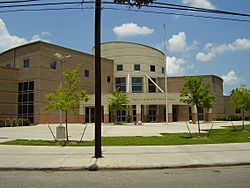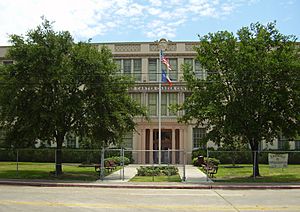Wheatley High School (Houston) facts for kids
Quick facts for kids Wheatley High School |
|
|---|---|

Wheatley High School
|
|
| Location | |
| Coordinates | 29°46′17″N 95°19′11″W / 29.7713°N 95.31982°W |
| Information | |
| Opened | 1927 |
| School board | Houston Independent School District |
| Teaching staff | 65.66 (FTE) |
| Grades | 9-12 |
| Enrollment | 616 (2023-2024) |
| Student to teacher ratio | 9.38 |
| Campus size | 14 acres (5.7 ha) |
| Campus type | Urban |
| Color(s) | |
| Team name | Wildcats |
| Last updated: 29 December 2017 | |
Phillis Wheatley High School is a high school in Houston, Texas, United States. It is located at 4801 Providence Street. The school is part of the Houston Independent School District. Wheatley High School is named after Phillis Wheatley, a famous poet. It is located in the Fifth Ward area of Houston.
Wheatley High School has a special program for technology. This program started in 2006. It came from another school that closed down. In 1979, the principal, Charles Herbert, said that for many people, the Fifth Ward is Wheatley High School. He noted that African-Americans who grew up there still felt a strong connection to the school.
Contents
School History
Early Years and Segregation
Wheatley High School first opened on January 31, 1927. It was in the old McGowan Elementary School building. In 1927, Wheatley was one of the largest high schools for Black students in the United States. It had 2,600 students and 60 teachers. This was during the Jim Crow era, when schools were separated by race.
By 1949, the first school building became too crowded. Students had to attend classes in different shifts. That year, a new, larger campus opened at 4900 Market Street. This new campus cost $2.5 million and covered 14 acres (5.7 ha). It was the most expensive high school built in Houston at that time. The school district wanted to show that separate schools for minority students could be just as good as schools for White students. The old Wheatley campus later became E.O. Smith Middle School. It then became the Carter Career Center.
In May 1965, a youth minister named William Lawson talked to Wheatley students. They discussed a possible school boycott. The school district was slowly ending segregation. However, African American leaders felt it was happening too slowly. Five days later, a boycott happened. About 10% of Wheatley students did not attend classes.
After Desegregation
In the 1970s, Houston ISD schools became desegregated. This meant students of all races could attend the same schools. The school district changed the attendance zones. This meant some White students from the Denver Harbor area were now zoned to Wheatley. This neighborhood was also becoming more Hispanic. Many Hispanic students preferred to go to other schools like Austin High School.
Some people felt that school spirit and discipline at Wheatley changed in the 1970s. The school stopped using physical punishment around this time. In 1979, Principal Herald said that desegregation caused some of the best students and teachers to leave the school.
In 1976, Wheatley's reading scores were low compared to other high schools. In 1978, the school district suggested ways to help Wheatley. These included smaller classes and better pay for teachers. In 1979, Principal Herald noted that test scores had gone down. However, he also said that the school was more peaceful than during the Civil Rights Movement. He added that many students were trying to get into college.
In the mid-1980s, there were concerns about safety near the school. In 1986, the superintendent thought about closing Wheatley. This was because of problems with academics and safety. However, many former students did not want their school to close.
In the 1990s, Wheatley had low test scores and many students dropping out. In 1995, it had the highest dropout rate in Houston ISD. In 1997, less than half of the high-school-age children living in the Wheatley area actually attended the school.
Recent Years (2000s to 2020s)
A study in 2007 called Wheatley a "dropout factory." This meant that many students who started as freshmen did not finish their senior year.
A new campus for Wheatley High School was built. It was designed by Willie Jordan, who was a former student of Wheatley. The new building opened in the fall of 2006. It is located on the same land as the old 4900 Market Street campus. The old campus was torn down. The new campus cost $35 million to build.
The number of students at Wheatley increased when another school, Middle College for Technology Careers, joined with Wheatley.
In 2019, the Texas Education Agency (TEA) gave Wheatley a failing grade. It was the only high school in Houston ISD to get this grade that year. This was the seventh year in a row the school had a failing grade. Wheatley officials said that if a certain rule did not exist, the school would have received a "D" grade. In November 2019, the TEA rejected Wheatley's appeal to change its grade. The school had asked for student scores to be excused due to Hurricane Harvey.
In 2023, the community was unsure if the TEA would keep the school open. This was because the TEA had taken control of Houston ISD.
Student Population
During the segregation era, Wheatley had a very large student body. It had about 3,600 students. This made it one of the largest high schools for Black students in the United States.
In 1979, the school had 1,197 Black students, 125 Hispanic students, and 8 White students.
In the 2004–2005 school year, Wheatley had 836 students. This was one of the lowest enrollments for a zoned high school in Houston ISD. By 2008, the number of students increased to 1,235.
Neighborhoods Served
Wheatley High School serves several neighborhoods in Houston. These include the Fifth Ward (like Frenchtown), Denver Harbor, Liberty Heights, and East Downtown. It also serves part of Kashmere Gardens.
Some public housing complexes are also zoned to Wheatley. These include Clayton Homes, Kelly Village, and Kennedy Place.
School Campus
The current Wheatley campus opened in June 2006. It cost $35 million. The architects who designed the campus won an award for their work. The school was featured in a magazine for its design.
In 2012, Richard Connelly of the Houston Press said Wheatley was one of the most beautiful high school campuses in Greater Houston. He liked its unique and playful design.
Wheatley is located in the Fifth Ward. It is near a highway and a park. In September 2014, the school board approved tearing down the old 1929 Wheatley High School building. Some people tried to stop the demolition with lawsuits. However, a judge dismissed the lawsuits in December 2014. The district then tore down the rest of the building. Houston ISD plans to build a new school on that site.
Sports
Before desegregation, Wheatley was very strong in high school basketball in Texas. However, it was not as strong in American football.
Basketball
The school won many state basketball championships. For 25 years, ending in 1974, 15 of its teams reached the state championships. Wheatley first played in leagues for Black schools. Around 1968, the University Interscholastic League (UIL) allowed Black schools to join. In 1968, Wheatley won the first high school basketball playoffs in Texas. They defeated the Thomas Jefferson High School team from Dallas with a score of 85–80 in overtime. This win gave Wheatley a perfect 36–0 record. From 1968 to 1974, Wheatley won four state championships. They won 219 games and lost only 11.
Many talented basketball players from Wheatley went on to play at Prairie View A&M University and Texas Southern University. By 1974, other larger universities also started recruiting Wheatley players.
Football
In the segregation era, schools for Black students played their football games on weekdays. Schools for White students played on Fridays.
Historically, the football game between Wheatley and Yates High School was very important. Before desegregation, Wheatley did not play against White high schools. Starting in 1927, the school's football team played Yates High School every Thanksgiving Day. These games were held at Jeppeson Stadium. The Yates-Wheatley Thanksgiving football game was very popular. It often had crowds of over 30,000 people. The rivalry became less intense after Yates joined the UIL. The Thanksgiving Day game ended after the football leagues became integrated.
Music Programs
Percy McDavid was a music teacher in the 1930s. He taught both classical music and jazz in orchestra classes. He helped create Wheatley's music programs during that time. Duke Ellington, a famous musician, visited in 1935 to hear Wheatley's orchestra. Many famous musicians graduated from Wheatley during this period. These include Arnett Cobb and Illinois Jacquet.
Famous Former Students
- Tom Archia, Jazz Tenor Saxophonist
- Archie Bell, musician
- Arnett Cobb, musician
- Donnie Davis, former professional football player
- Harold Dutton Jr., Texas State Representative
- Albert "Al" Edwards, Texas State Representative
- Dr. Marion Ford, dentist and Guggenheim fellow
- George Foreman, boxing champion
- Everett Gay, former NFL player
- Lester Hayes, former NFL player
- Clarence Hollimon, guitarist
- Xavien Howard, American football player
- William Jackson III, American football player
- Illinois Jacquet, jazz musician
- Cliff Johnson, retired baseball player
- Dwight Elmo Jones, basketball player
- Barbara Jordan, first African-American U.S. Congresswoman from the Southern United States
- Mickey Leland, member of the Texas House of Representatives
- Kanavis McGhee, former professional football player
- Ruth Jones McClendon, Texas State Representative
- Grady Richardson, former NFL player
- Ruth Simmons, president of Brown University
- Joe Sample, member of The Crusaders
- Eldridge Small, former professional football player
- Fred Taylor, retired NBA player
- Godwin Turk, professional football player
- Hubert Laws, flautist and member of The Crusaders
- Sid Williams, former NFL player and United States Ambassador
- Willie Williams, football player
- Jim Young, NFL player
Feeder Schools
Elementary schools that send students to Wheatley include:
- Dogan
- Eliot
- N.Q. Henderson
- R. Martinez
- Pugh
- Scroggins
- Bruce (part of the school's area)
- Burnet (part of the school's area)
- Isaacs (part of the school's area)
- Lantrip (part of the school's area)
- Ross (part of the school's area)
- Scott (part of the school's area)
Middle schools that send students to Wheatley include:
- McReynolds
- Fleming (part of the school's area)
- Yolanda Black Navarro (part of the school's area)
See also
 In Spanish: Escuela Preparatoria Wheatley (Houston) para niños
In Spanish: Escuela Preparatoria Wheatley (Houston) para niños



